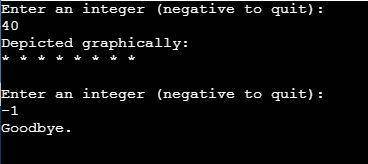
Computers and Technology, 17.06.2021 22:20 rosehayden21
Here is a nested loop example that graphically depicts an integer's magnitude by using asterisks, creating what is commonly called a histogram: Run the program below and observe the output. Modify the program to print one asterisk per 5 units. So if the user enters 40, print 8 asterisks. num = 0while num >= 0: num = int(input('Enter an integer (negative to quit):\n')) if num >= 0: print('Depicted graphically:') for i in range(num): print('*', end=' ') print('\n')print('Goodbye.')

Answers: 1


Another question on Computers and Technology

Computers and Technology, 22.06.2019 06:30
Exchanging which type of data uses the least bandwidth? music photographs video voice bandwidth- the amount of data that can be moved between two points in a set time period
Answers: 1

Computers and Technology, 22.06.2019 10:30
You have a large, late-model pick-up truck with a rear seat. the pick-up truck weighs 6,500 pounds. the florida seat belt law
Answers: 1


Computers and Technology, 23.06.2019 14:30
Select the correct answer. sean is a computer programmer. he has programmed an application for toddlers that plays nursery rhymes. however, a logic error has occurred in the program. which problem is a likely consequence of the error? a. the program crashes every time the user wants to play the nursery rhymes. b. the program crosses its buffer boundaries and overwrites an adjacent program. c. the program plays a different nursery rhyme than the one the user intended to play. d. the program shows different structures in its programming language code. e. the program introduces new viruses every time the user plays a nursery rhyme.
Answers: 1
You know the right answer?
Here is a nested loop example that graphically depicts an integer's magnitude by using asterisks, cr...
Questions


Computers and Technology, 04.07.2019 21:20



Computers and Technology, 04.07.2019 21:20


Computers and Technology, 04.07.2019 21:20

Computers and Technology, 04.07.2019 21:20

Computers and Technology, 04.07.2019 21:20

Computers and Technology, 04.07.2019 21:20


Computers and Technology, 04.07.2019 21:20








Biology, 04.07.2019 21:20





